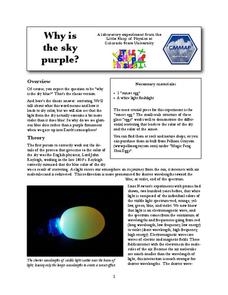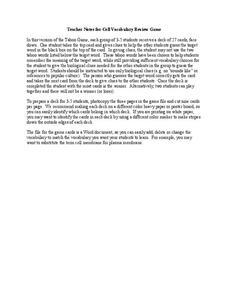California Academy of Science
Color Vision Genetics Evolution Simulation
At one point, all mammals carried only two color receptors, but now most humans carry three. An informative presentation and hands-on activity demonstrate how this evolved through genetics. By participating in the activity, pupils...
Curated OER
The Color Spectrum
What is a color spectrum? Simple, it's comprised of the colors of the rainbow. Have the classs read a passage about the color spectrum and then complete two short answer activities.
Curated OER
Take-Home Midterm Exam #3, Part A
Let your physics learners take this electromagnetic radiation exam home to show what they know. You could also use it in class or assign it as a review. The content covers concepts pertaining to color, wavelength, frequency,...
SF Environment
Sort and Color!
Sorting is a very important skill that can be used in math and even science. Learners get familiar with some environmentally friendly vocabulary terms as they practice separating objects that can be recycled from those that can't. They...
Curated OER
Hair and Eye Color
In this human biology interactive worksheet, students identify the color of hair and eyes in each illustration by choosing the appropriate color from the drop down menu. There are four questions to complete, as well as a crossword puzzle.
Curated OER
Color
In this color worksheet, students read where light comes from and the different colors created through a prism. Students compare light (additive color) with pigments (subtractive color). Then students complete 1 drawing, 6 matching, 22...
Colorado State University
Why Is the Sky Purple?
The color of the sky depends on the time of day. Young scholars experiment with scattering different wavelengths of light to recreate the color of the sky. They observe both the longer blue wavelengths and the shorter red and orange...
Curated OER
Shrinky Dinks® Palettes
Here is a fun and clever lesson for teaching physics classes how to calculate wavelength if given the energy and frequency data. On a worksheet, they compute wavelengths using a table of information that you provide. On a paper palette,...
Serendip
Cell Vocabulary Review Game
Can science scholars describe a nucleus without mentioning DNA, or a chloroplast without mentioning the color green? Test their organelle understanding through an exciting card game. Groups take turns guessing the correct organelle or...
Curated OER
DNA Coloring - Transcription and Translation
In this DNA worksheet, pupils review the transcription and translation processes. Students label and color the different parts of a DNA strand. This worksheet has 7 fill in the blank questions.
Curated OER
How Do The Colors of Light Mix?
Students investigate the mixing of light. They form a hypotheses to reason why color changes occur and they write conclusions and ask new questions arising from the investigation. Students identify the primary and complementary colors of...
Dr. Seuss Enterprises
I Speak for the Trees!
Celebrate the environment and Earth Day with Dr. Seuss's The Lorax. Kids get to color in a picture and complete a few word puzzles. Also included is a poster encouraging kids to recycle.
Curated OER
What's Your Color?
In this animal camouflage learning exercise, learners study 8 color names. They are asked to write an animal that would use this color as an adaptation. Students need to describe how this would help the animal.
Curated OER
Starlight, Star Heat
In this stars worksheet, students read how astronomers calculate the temperature of a star by measuring its color. Students use a chart showing star temperatures and colors to complete 3 short answer questions.
Curated OER
Planting a Rainbow Bulletin Board
Students explore a variety of colors and shapes after reading the story, "Planting A Rainbow," by Lois Ehlert. The tracking and reading of labels attached to diagrams form an experience in vocabulary development in this lesson.
Curated OER
Scientific Root Words, Prefixes, and Suffixes
It's hard to imagine that anything was missed on this five-page list of science roots, prefixes, and suffixes! Listed in alphabetical order, all are included in a single, two-column list. This may be especially useful for advanced...
Curated OER
Plant Parts
Little ones identify the parts of a plant and practice following directions at the same time. They color each part of the flowering plant the color indicated on the sheet. Roots are brown, leaves are green, the flower is red, and the...
Curated OER
Arthropod Coloring
In this arthropod worksheet, students compare and contrast the different animals found in the Phylum Arthropoda: insects, arachnids, and crustaceans. Students complete 8 fill in the blank statements and color illustrations.
Curated OER
A Hidden Beauty
Expose the beautiful mystery of bulbs as young botanists learn all about these fascinating plants. They glean information from a short text before observing actual bulbs (consider an onion), and comparing their findings with predictions....
Curated OER
Which Colored Filter Will Decode a Secret Message?
Students investigate how to create secrete messages through filters. They view pictures with red and green filters and discuss what they observe. They select the color filter that works best to read secret messages. They view pictures...
Curated OER
Word Search: Australian Reptiles & Amphibians
In this word search worksheet, learners will find and circle the names of 21 Australian reptiles and amphibians. A realistic, color picture accompanies the name of each animal.
Curated OER
Tomato Exploration
Create tomatoes in 15-20 minutes using this fun and interactive lesson plan! Learners listen to a book about tomatoes (recommendations listed), and focus on the vocabulary word tomato. They count the syllables...
Curated OER
The Membrane Potential
Give this summary of 16 pages of a text to your class to deepen understanding of cell permeability, diffusion, ions, and more. The handout portion includes vocabulary clarifications, detailed color diagrams, and important information;...
Curated OER
Match Shapes in Compositions
Third graders draw shapes that are congruent with each other and identify other congruent shapes. In this congruency lesson plan, 3rd graders also apply specific colors from the color wheel in their shapes.























